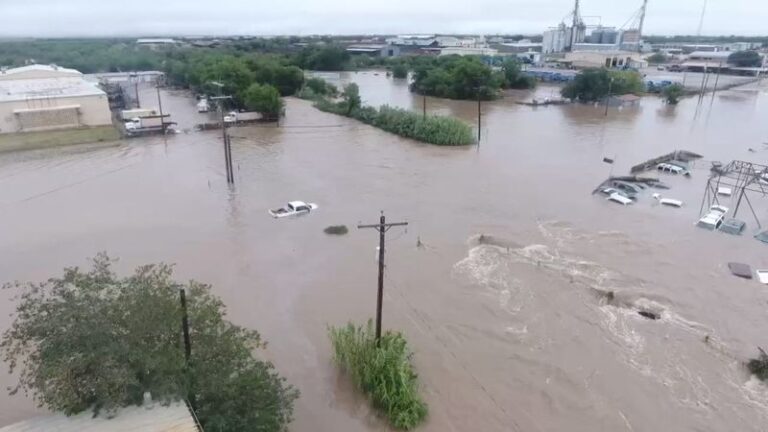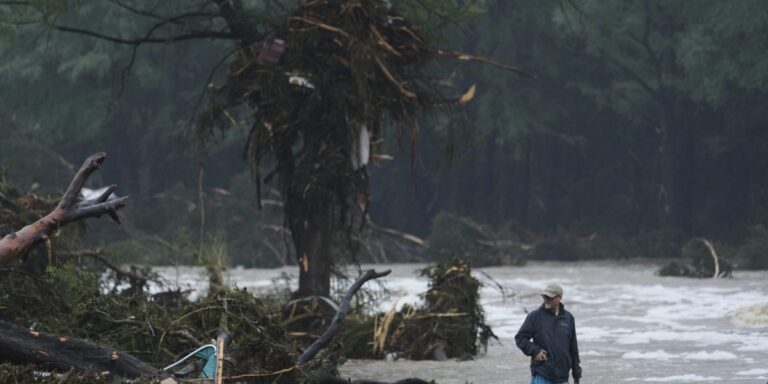Rescuers scoured flooded riverbanks littered with mangled trees Saturday and turned over rocks in the search for more than two dozen children from a girls’ camp and many others missing after a wall of water blasted down a river in the Texas Hill Country. The storm killed at least 37 people across the state, including 14 children.
Some 36 hours after the floods, authorities still have not said how many people were missing beyond 27 children from Camp Mystic, a Christian summer camp along a river in Kerr County where most of the dead were recovered.
The destructive fast-moving waters rose 26 feet (8 meters) on the Guadalupe River in just 45 minutes before daybreak Friday, washing away homes and vehicles. The danger was not over as torrential rains continued pounding communities outside San Antonio on Saturday and flash flood warnings and watches remained in effect.
Searchers used helicopters, boats and drones to look for victims and to rescue people stranded in trees and from camps isolated by washed-out roads.
Texas Gov. Greg Abbott vowed that authorities will be relentless in rescuing and recovering victims. “We will find every one of them,” he said.
The number of victims climbed as more rain continued around Austin and a massive search continued in the nearby Hill Country. At least three people died and 10 others were missing in Travis County, home to the state’s capital.
Two people died in Burnet County, where a firefighter was among the missing after he was swept away by floodwaters while responding to a rescue, the county Emergency Management Coordinator Derek Marchio said.
Kerr County Sheriff Larry Leitha said the bodies of 32 people had been recovered so far in the devastated Hill Country: 18 adults and 14 children.
Authorities were coming under growing scrutiny over whether the camps and residents in places long vulnerable to flooding received proper warning and whether enough preparations were made.
The hills along the Guadalupe River in central Texas are dotted with century-old youth camps and campgrounds where generations of families have come to swim and enjoy the outdoors. The area is especially popular around the July Fourth holiday, making it more difficult to know how many are missing.
“We don’t even want to begin to estimate at this time,” City Manager Dalton Rice said Saturday morning.
Raging storm hit camp in middle of the night
“The camp was completely destroyed,” said Elinor Lester, 13, one of hundreds of campers. “A helicopter landed and started taking people away. It was really scary.”
A raging storm fueled by incredible amounts of moisture woke up her cabin just after midnight Friday, and when rescuers arrived, they tied a rope for the girls to hold as they walked across a bridge with water whipping around their legs, she said.
Frantic parents and families posted photos of missing loved ones and pleas for information.
On Saturday, the camp was mostly deserted. Helicopters roared above as a few people looked at the damage, including a pickup truck tossed onto its side and a building missing its entire front wall.
Among those confirmed dead were an 8-year-old girl from Mountain Brook, Alabama, who was staying at Camp Mystic, and the director of another camp just up the road.
The flooding in the middle of the night caught many residents, campers and officials by surprise in the Hill Country, which sits northwest of San Antonio.
AccuWeather said the private forecasting company and the National Weather Service sent warnings about potential flash flooding hours before the devastation.
“These warnings should have provided officials with ample time to evacuate camps such as Camp Mystic and get people to safety,” AccuWeather said in a statement that called the Hill Country one of the most flash-flood-prone areas of the U.S. because of its terrain and many water crossings.
The National Weather Service sent out a series of flash flood warnings in the early hours Friday before issuing flash flood emergencies — a rare alert notifying of imminent danger.
Officials defended their actions while saying they had not expected such an intense downpour that was the equivalent of months’ worth of rain for the area.
One National Weather Service forecast earlier in the week “did not predict the amount of rain that we saw,” said Nim Kidd, chief of the Texas Division of Emergency Management.
Helicopters, drones used in frantic search for missing
Search crews were facing harsh conditions while “looking in every possible location,” Rice said.
Authorities said about 850 people had been rescued. U.S. Coast Guard helicopters were flying in to assist.
One reunification center at an elementary school was mostly quiet Saturday after taking in hundreds of evacuees the day before.
“We still have people coming here looking for their loved ones. We’ve had a little success, but not much,” said Bobby Templeton, superintendent of Ingram Independent School District.
Homeland Security Secretary Kristi Noem arrived and pledged that the Trump administration would use all available resources.
Residents clung to trees, fled to attics
In Ingram, Erin Burgess woke to thunder and rain in the middle of the night Friday. Just 20 minutes later, water was pouring into her home, she said. She described an agonizing hour clinging to a tree with her teenage son.
“My son and I floated to a tree where we hung onto it, and my boyfriend and my dog floated away. He was lost for a while, but we found them,” she said.
Barry Adelman said water pushed everyone in his three-story house into the attic, including his 94-year-old grandmother and 9-year-old grandson.
“I was having to look at my grandson in the face and tell him everything was going to be OK, but inside I was scared to death,” he said.
Local resident know it as “ flash flood alley. ”
“When it rains, water doesn’t soak into the soil,” said Austin Dickson, CEO of the Community Foundation of the Texas Hill Country, which was collecting donations. “It rushes down the hill.”
‘No one knew this kind of flood was coming’
The forecast for the weekend had called for rain, with a flood watch upgraded to a warning overnight Friday for at least 30,000 people. Texas Lt. Gov. Dan Patrick said the potential for heavy rain and flooding covered a large area.
“Everything was done to give them a heads up that you could have heavy rain, and we’re not exactly sure where it’s going to land,” Patrick said. “Obviously as it got dark last night, we got into the wee morning of the hours, that’s when the storm started to zero in.”
Kerr County Judge Rob Kelly, the county’s chief elected official, said: “We do not have a warning system.”
When pushed on why more precautions weren’t taken, Kelly said no one knew this kind of flood was coming.
More pockets of heavy rains expected
The slow-moving storm brought more rain Saturday and had the potential for pockets of heavy downpours and more flooding, said Jason Runyen, of the National Weather Service.
The threat could linger overnight and into Sunday morning, he said.




















